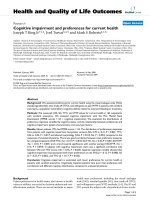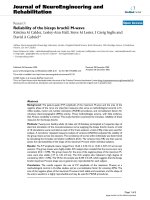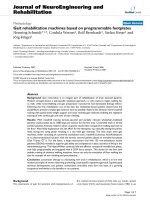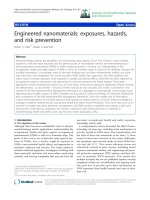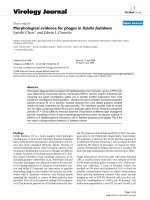Báo cáo hóa học: " Unexpected bilateral massive pulmonary embolism Zaffer Qasim" ppt
Bạn đang xem bản rút gọn của tài liệu. Xem và tải ngay bản đầy đủ của tài liệu tại đây (333.73 KB, 2 trang )
CAS E RE P O R T Open Access
Unexpected bilateral massive pulmonary
embolism
Zaffer Qasim
Case report
A 59-year-old woman with a past history of rheuma toid
arthritis arrived in our Emergency Department via
ambulance. Her husband stated she had suddenly
“appeared very strange” whilst preparing to go out for
the afternoon, but could not identify specific symptoms.
Physical examination showed her to have sinus tachycar-
dia and tachypnea, but little else of note. Her oxygen
saturations however rapidly dropped when she was
taken off high-flow oxygen. Her D-dimer assay was
markedly elevated, and urgent computed tomographic
pulmon ary angiography (CTPA) was performed (Figures
1 and 2). This showed large emboli (black arrows) in
boththeleft(Figure1)andright(Figure2)pulmonary
arteries (white arrows), with a saddle embolus noted on
the right. Following the CTPA, she develop ed signs and
symptoms of obstructive shock, requiring urgent throm-
bolysis using tenectaplase and admission to the intensive
care unit. Her hospital stay was complicated by a lower
respiratory tract infection, but she was discharged 17
days after her admission.
Rheumatoid arthritis may be complicated by venous
thrombotic disease with up to 33% of cases being asso-
ciated with antiphospholipid syndrome [1]. Antipho-
spholipid antibodies may have precipitated the events in
our patient. When the patient’ s condition deteriorated,
we resorted to thrombolytic therapy. There are clear
indications for the administration of thromobolytic
agents. The most recent recommendations from the
American College of Chest Physicians [2] advise its use
with evidence of hemodynamic compromise in the
absence of contraindications to therapy, ideally via a
peripheral vein, and utilizing a regimen with a short
infusion time. There is less robust evidence to support
the use of thrombolytics f or high-risk, normotensive
patients assessed to have a low bleeding risk, but outside
these conditions, thrombolytics are not recommended.
Correspondence:
Emergency Department, Manchester Royal Infirmary, Oxford Road,
Manchester M13 9WL, UK
Figure 1 CTPA image of left pulmonary artery showing saddle
embolus (black arrows).
Figure 2 CTPA image showing similar saddle embolus (white
arrows) in right pulmonary artery of the same patient.
Qasim International Journal of Emergency Medicine 2011, 4:70
/>© 2011 Qasim; licensee Springe r. This is an Open Access article distributed under the terms of th e Creative Commons Attribution
License ( which permits unrestricted use, distribution, and reprodu ction in any medium,
provided the original work is properly cited.
Competing interests
The author declares no competing interests.
Received: 22 June 2010 Accepted: 18 November 2011
Published: 18 November 2011
References
1. Gladd DA, Olech E: Antiphospholipid antibodies in rheumatoid arthritis:
identifying the dominoes. Curr Rheumatol Rep 2009, 11(1):43-51.
2. Kearon C, Kahn SR, Agnelli G, Goldhaber S, Raskob GE, Comerota AJ:
Antithrombotic therapy for venous thromboembolic disease: American
College of Chest Physicians Evidence-Based Clinical Practice Guideline.
Chest , 8 2008, 133(6 Suppl):454S-545S.
doi:10.1186/1865-1380-4-70
Cite this article as: Qasim: Unexpected bilateral massive pulmonary
embolism. International Journal of Emergency Medicine 2011 4:70.
Submit your manuscript to a
journal and benefi t from:
7 Convenient online submission
7 Rigorous peer review
7 Immediate publication on acceptance
7 Open access: articles freely available online
7 High visibility within the fi eld
7 Retaining the copyright to your article
Submit your next manuscript at 7 springeropen.com
Qasim International Journal of Emergency Medicine 2011, 4:70
/>Page 2 of 2


